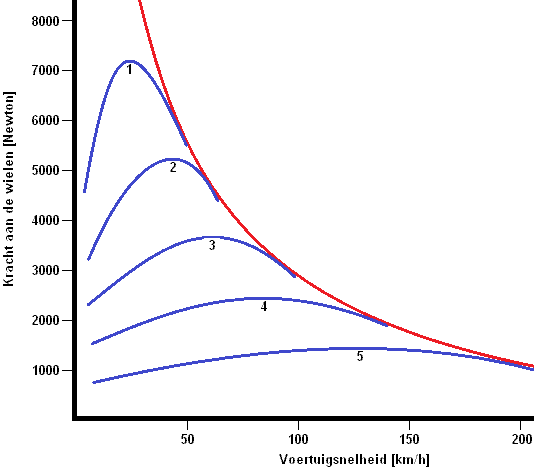Subjects:
- General Information
- Single and double reduction
- Gearbox in longitudinal or transverse direction
- Gears and gears
- Gearbox operation
- Synchronizing Device
- Disassemble gearbox
- Constant Mesh
- Sliding Mesh
- Gear ratios
General information:
The purpose of a gearbox is to adapt the engine speed and thus the available engine torque and power to different driving conditions. This can be when accelerating or decelerating, transporting a heavy load, going up and down slopes and changes in air and rolling resistance that can occur while driving. Shifting to a more favorable gear under these different conditions will in most cases result in better fuel economy and more torque and power.
In a low gear (eg second) more engine torque is available than in a higher gear (eg fourth). This is because the crankshaft of the engine makes more revolutions in second gear and revs much faster when accelerating than in a higher gear. It is therefore wiser not to drive in too high a gear while driving with a heavy load, such as a caravan. Certainly not in the mountains.
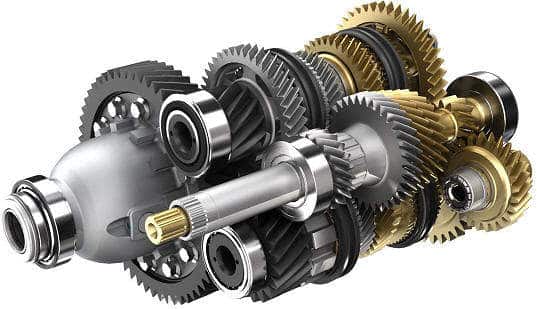
Between the engine and the gearbox is the link which is equipped with a clutch plate, a pressure group and a release bearing. By pushing the clutch pedal, the pressure group is operated via a cable. With a hydraulic clutch, a fluid is moved from one cylinder to the other by means of two clutch cylinders.
Below is a block diagram of how the drive from the engine to the wheels is created in front-wheel, rear-wheel and four-wheel drive. For more information about this, see the page drivetrains.
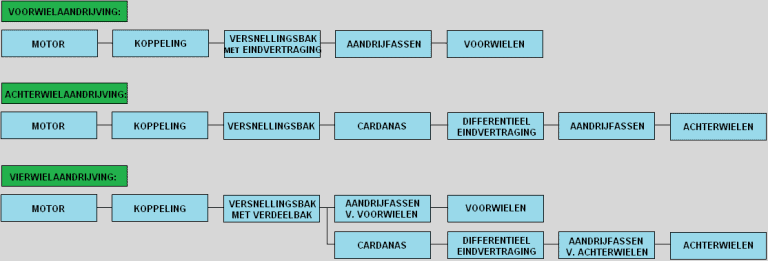
Single and double reduction:
Manual gearboxes are divided into two groups, namely single and double reduction. Reduction is another word for transmission. So it actually means “single and double” transmission. Below is a picture of what it means.
Single Reduction
The gears of the input and output shaft are directly connected to each other.
A: Input shaft (drive shaft, from the engine)
B: Output shaft (main shaft)
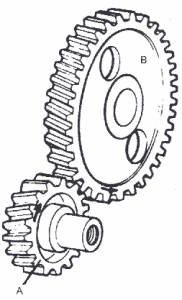
Double Reduction
First gear is engaged; the driving forces in first gear go from A to B and from C and to D.
A force is applied to gear A via the input shaft. This gear is in direct connection with gears B, D and E. Since the first gear is engaged, the synchronizing device has coupled the output shaft to gear D (see blue arrows). From gear B, the drive forces leave the gearbox via the output shaft. The output shaft drives the differential, which may be in the gearbox (on front wheel drive cars) or the differential may be mounted in another location, such as on a rear wheel drive car. More on this will be explained later on this page.
A: Gear input shaft (drive shaft, from the motor)
B, C & E: Secondary Shaft Gears
D & F: Output Shaft Gears (Main Shaft)
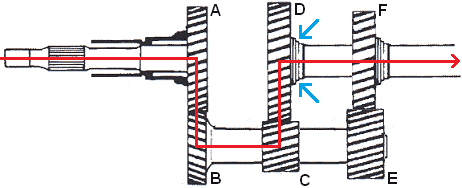
The second gear is engaged. The synchronizing device is disengaged from gear D and engaged at gear F (see blue arrows). At that moment, gear D rotates with it, but is not coupled to the output shaft. Gear F is, so the driving forces now go from A to B and from E to F.
Because the gears C and E have different dimensions, the gear ratios have changed. As a result, the engine speed has dropped after coupling at the same vehicle speed.
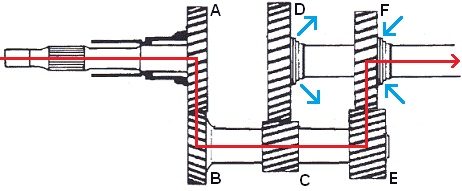
Gearbox in longitudinal or transverse direction:
The image shows a schematic of a rear-wheel drive car. The engine block is placed longitudinally (lengthwise) and the gearbox is equipped with a double reduction. The final deceleration (the differential) is located at the rear axle and drives the rear wheels. This is the type of drive that BMW makes a lot of use of.
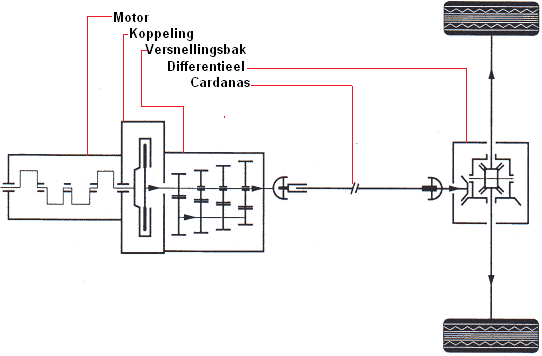
This image shows a schematic of a front wheel drive car. The engine block is transversely placed (in width) and the gearbox is equipped with a single reduction.
The driving forces enter at the input shaft (the input shaft) and are transmitted to the output shaft via the engaged gears. The differential is integrated in the gearbox housing. This type of drive is used in a Volkswagen Golf and a Ford Focus (and of course with many other brands!)
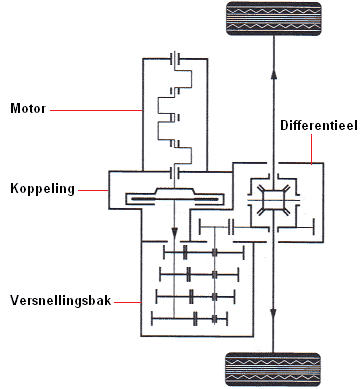
The image shows a schematic of a front wheel drive car. Both the engine block and the gearbox are placed lengthwise. The engine block is located in front of the front axle and the gearbox behind the rear axle. The differential is mounted at the level of the drive shafts. This system has been applied to the older models VW Passat, Skoda Superb and Audi A4. The newer models now have a transversely placed engine block (so the situation below).
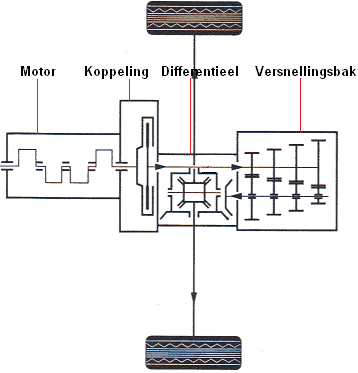
Gears and gears:
Different gear ratios can be achieved with the different sizes of the gears. We call these transmission ratios gears. When a large gear is driven by a small gear, the small gear can, for example, make 3 revolutions, while the large gear only turns once. The transmission ratio is then 1:1. The delay and the power increase are then 3x as great. When the small gear has 3 teeth, the large gear will have 20 teeth.
Below you can see the different gears that can be switched. You can see that with every gear the right gear of the top shaft (the primary shaft) in gears 2 and 3 gets smaller and smaller. The sprocket on the right side on the countershaft keeps getting bigger. As a result, the transmission ratio is constantly increased, which is the ultimate goal for shifting to another gear.
First gear:
The drive force enters the input shaft at the left of the arrow. The driving force is directly transmitted to the countershaft gear. The secondary shaft is the lower shaft. The smallest gear on the countershaft is coupled to the penultimate gear of the output shaft. Due to the size of the gears, the output shaft rotates a lot slower than the input shaft. This caused the greatest delay. The first gear has the greatest deceleration, so that it can be accelerated from a standstill with a lot of torque increase.

Second gear:
The gears on the left remain engaged. The driving force goes through the third gear of the countershaft to the third gear of the output shaft. The output shaft still rotates slower than the input shaft. So there is still a delay. The deceleration is now smaller than with first gear, so a higher vehicle speed can be achieved at the same engine speed than with first gear.

Third gear:
The drive power goes through the second gear of the countershaft and the second gear of the output shaft. The output shaft still rotates slower than the input shaft. The deceleration is now smaller again than with second gear, so even now a higher vehicle speed can be achieved at the same engine speed than with second gear.

Fourth gear:
This is called prize direct. The driving force goes from the input shaft directly to the output shaft. The engine torque is therefore transmitted 1 to 1 to the wheels. In fact, the gearbox does not participate right now.
With a five-speed gearbox, fourth gear is always direct direct. However, with a 6-speed gearbox, the fifth gear is direct-prise.

Fifth gear:
In fifth gear, the two rear sprockets are connected to each other. The largest gear of the secondary shaft is coupled to the smallest gear of the output shaft. This is called the 'overdrive'. The output shaft now rotates faster than the input shaft.
Gears 1, 2 and 3 are decelerations; the input shaft rotates faster than the output shaft. In fourth gear, the input shaft rotates just as fast as the output shaft (prise-direct). With this 5th gear there is therefore a real acceleration, because with this gear the output shaft is the only one of all the gears that rotates faster than the input shaft. When driving on the highway, the engine speed will therefore be lower. When accelerating, you often have to downshift to a lower gear.

Backwards:
When selecting reverse, an extra gear is placed between the gears of the secondary and output shafts. Normally, if the lower gear rotates counterclockwise, the upper gear mounted against it will rotate clockwise. When you put another gear next to that clockwise rotating gear, it will turn left again. This is in fact also done in the gearbox. The input shaft just drives in the normal way, and because of the extra gear the output shaft will turn on the other can.
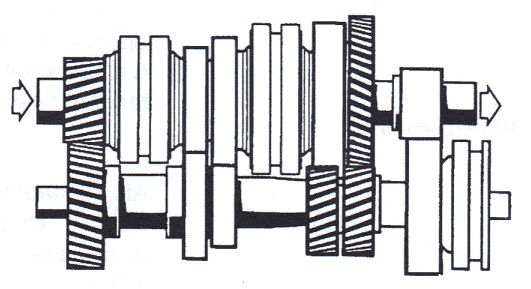
Conclusion:
It has been explained above that by coupling gears of different sizes, a different transmission ratio (ie acceleration) is created and how the driveline then runs. Below is an explanation of how gear engagement and disengagement work when the lever is operated.
Gearbox operation:
When the gear lever is moved in the interior, the cables or rods (depending on the type of gearbox/mechanics) are moved that go to the gearbox.
The image below shows that the balladeura axis can move back and forth. This space is indicated in pink. The balladura operates the shift fork. The shift fork presses the synchro ring against the sprocket with the help of the shift ring. When shifting to the next gear, the balladura moves back, putting the shift fork in the neutral position. By shifting into a different gear, the same shift fork is moved by the balladeura axle in the opposite direction to engage the other gear (e.g. from XNUMXrd to XNUMXth gear) or a different balladeura axle is used to shift the other shift forks. operate.
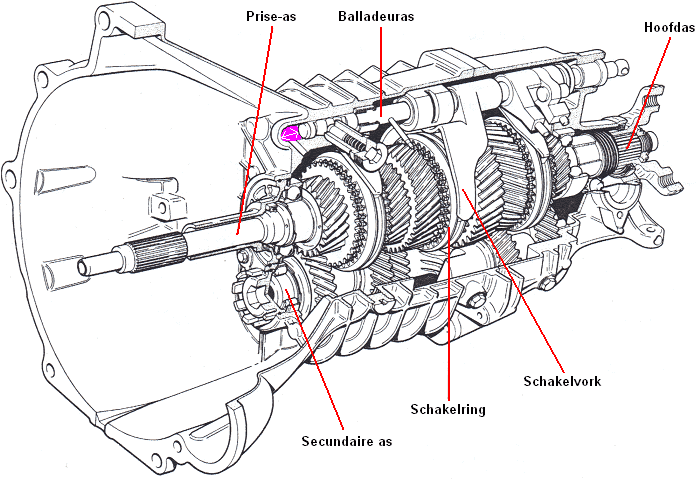
There are several ballads in the gearbox. Each balladura can engage or disengage two gears. The various ballade axes are operated by moving the gear lever to the left and right. The image below shows the H pattern of the gears.
When the driver wants to engage first gear, he will first move the gear lever from the center (N of 'neutral') to the left. The shift shaft will engage the teeth of the first and second gear ballad shafts.
Moving the lever up (to XNUMXst gear) moves the balladura backwards (in the picture to the top right). With this, the shift fork connects the gear of the first gear to the shaft.
To shift to second gear, the lever will have to be moved down (to neutral). The shift fork breaks the connection between the shaft and the sprocket. By moving the lever further down, the same shift fork will connect the other gear to the shaft; second gear is now engaged. This balladura therefore shifts the shift fork between the first and second gear.
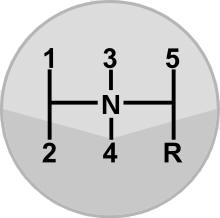
To shift to third gear, the second gear gear must first be disengaged from the shaft. For this, the poker must first be moved upwards again (to the neutral position). Then the poker must be moved to the center of the H-pattern. Moving the lever from left to center engages the third and fourth gear ballads. Pushing the lever back and forth will cause the third and fourth gear shift forks to be moved forward or back to engage these gears.
When shifting up to fifth gear, the lever is pushed all the way to the right. Hereby the balladuras of the fifth gear and the reverse are coupled. To select fifth gear, the balladura shaft is pushed forward, allowing the shift fork to connect the sprocket to the shaft.
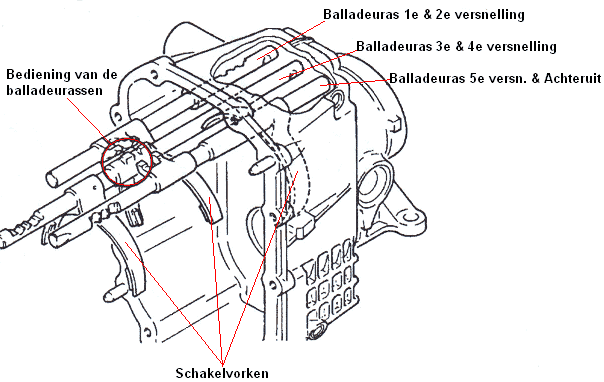
The picture shows a switching mechanism. This cable-operated mechanism is used in a car with a transversely placed engine block. Because the handles 1 and 2 are moved by the pushing or pulling movement of the cables, the shifting forks are moved through a so-called shifting tower.
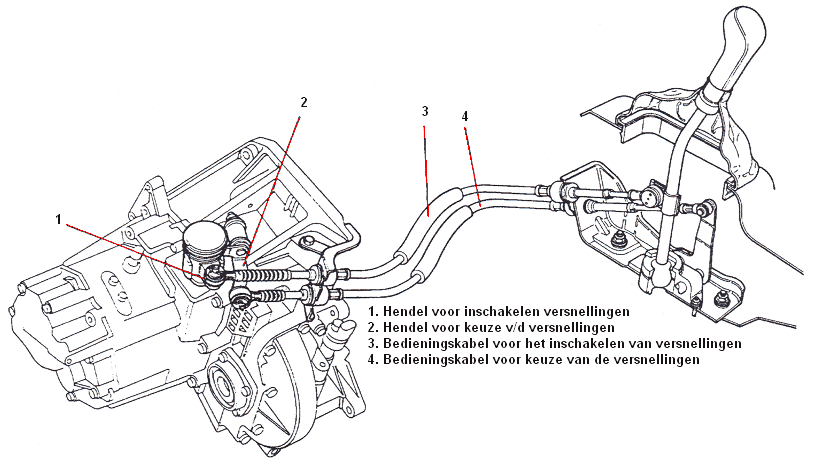
Synchronizing device:
If no synchronizing device is used, the gears will not mesh or squeak together due to the difference in speed. Synchromesh rings are used to ensure smooth coupling of the gears. The synchromesh rings ensure that the speeds of the shaft and the gear wheel are equal to each other when switching on. All gears (1 to 5 or 6) are synchronized, often except for the reverse gear. You will also notice that, because the sprocket sometimes wants to creak when engaging reverse gear. Sometimes the reverse gears are synchronized.
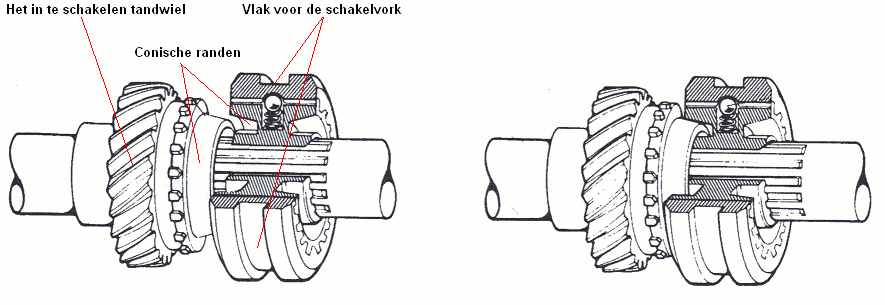
The gears of the gears that are not engaged rotate freely about the output shaft. Engaging a gear therefore means coupling a freely rotating gear to the output shaft. When a gear is engaged, the speed of the output shaft must match the speed of the gear to be engaged. The synchromesh ring is connected to the output shaft by means of splines and therefore also rotates at the same speed as this output shaft. The gear that must be engaged has a different speed than the output shaft, so also a different speed than the synchromesh. Because the shift fork moves, it takes the synchromesh with it and the conical part of the synchromesh ring will be pressed against the internal conical surface of the sprocket. The conical parts of both parts are pressed against each other, so that the friction between the conical surfaces is equalized. When there is no longer a difference in speed between the two gears, the shift sleeve can be pushed through so that the teeth slide into each other and the gear is engaged without creaking. The synchronizing device works not only when the gears are engaged, but also when shifting and downshifting.
It is very bad for the synchro rings to shift very quickly, so to push the lever very hard into a gear. The synchromesh will not have time to synchronize. It is therefore best to gently press the lever against the resistance when shifting and only push through when it almost automatically goes into gear.
A synchro ring is a wear part. Friction occurs during shifting, so the part will wear out over time. With normal use, the synchro ring can last a car life, but with improper use or sporty shifting, the synchro ring will wear out prematurely. The distance (3) between the synchro ring and the sprocket in the picture below will decrease. This is because the synchro ring wears on the interface where it touches the gear. This part is indicated by distance 1.
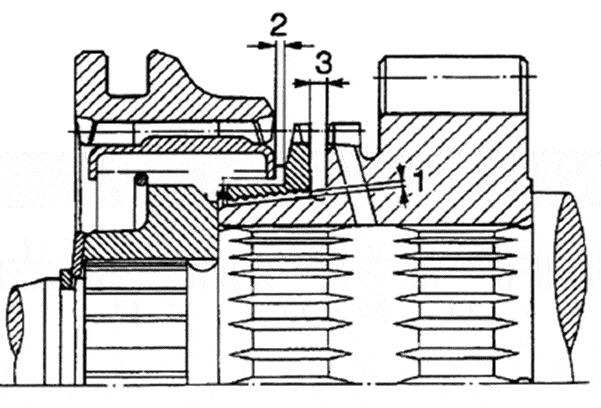
When the gearbox has been disassembled, the synchro rings can be checked for wear. The distance between the synchro ring and the sprocket can be measured with a feeler gauge. The gear must not be engaged in this case. With a wearing synchro ring, the distance between the synchro ring and the gear becomes smaller.
The manufacturer of the car or gearbox describes the wear limit of the synchro ring in the workshop documentation. If the measured value is less than the maximum wear value in the workshop documentation, it must be replaced.
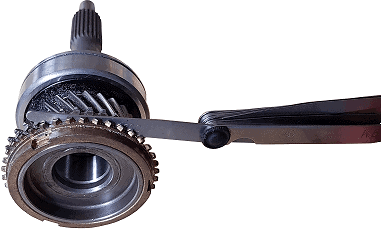
Disassemble gearbox:
This section describes how to disassemble a gearbox. This gives a good picture of what the inside of the gearbox actually looks like and how the parts in the gearbox can be replaced. This concerns a gearbox of a rear-wheel drive car in which the engine is mounted longitudinally.
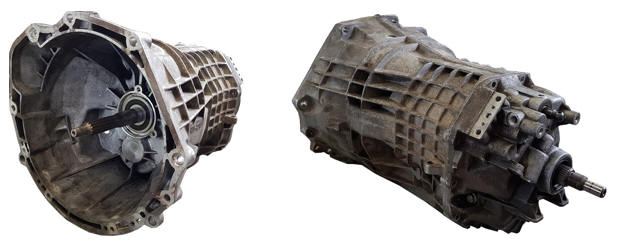
A number of bolts can be removed at the rear of the gearbox shown. The rear can then be slid off. Of course, the gearbox oil must first be drained before any parts are disassembled.
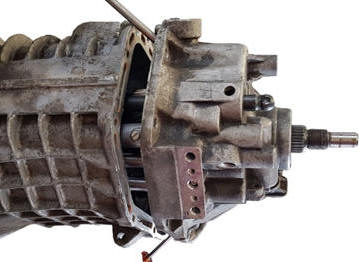
The interior with the shafts and gears is fixed at the back. The complete interior comes out of the gearbox housing when dismantled.
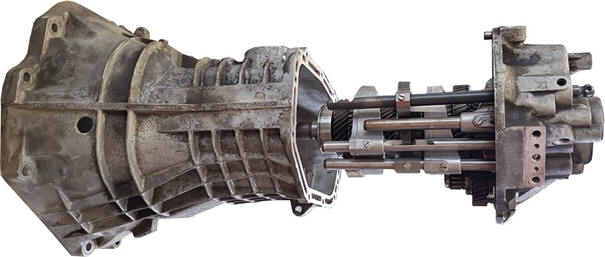
The bearing of the secondary shaft can be seen on the inside (on the right side of the hole through which the primary shaft is mounted when mounted).
Five holes can be seen on the left side of the hole of the input shaft. In these five holes are the four ends of balladeer shafts.
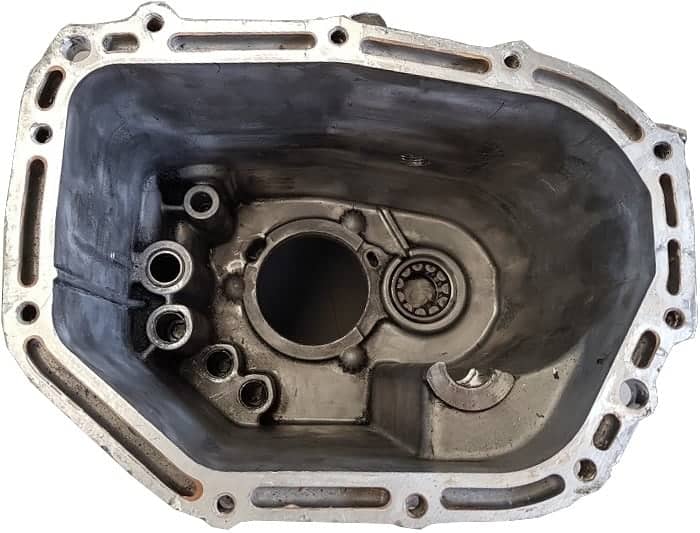
The image shows the drive shaft, gears and ballads with the shift forks. When shifting, the respective balladura turns and moves so that the shift fork operates the gear synchro ring to engage the gear.
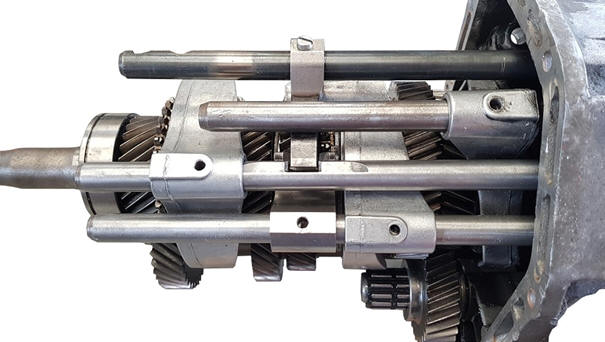
After the clamped pins or screws have been removed with which the shift forks on the balladeer shafts are connected, the balladeer shafts can be slid out. This will loosen the shift forks. The shift forks can be slid off the axles.
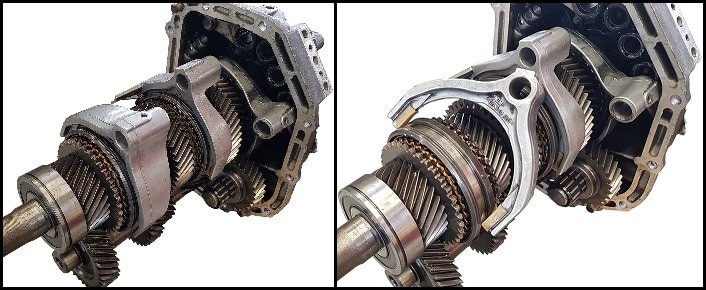
The image below shows what the gears look like. When gears or synchro rings need to be replaced, the shafts must be removed from the other side of the gearbox housing. The gears and the synchronizing device must be pressed off the shafts. The new parts must then be pressed back onto the shaft.
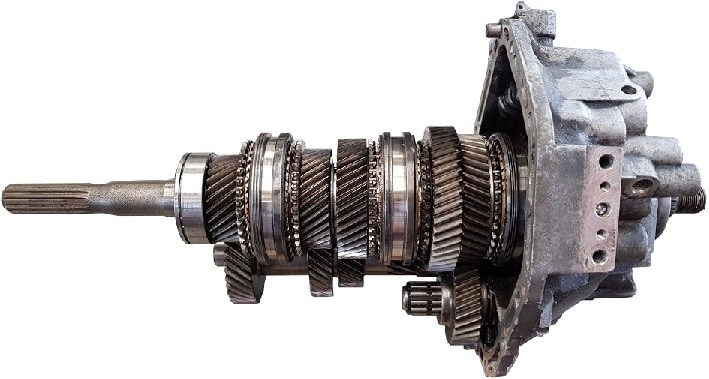
To check whether the synchro rings are still OK, the distance between the gear wheel and the synchro ring must be measured. If the distance is greater than the maximum value specified by the manufacturer, the synchro ring is worn. The synchro ring will need to be replaced. How the measurement should be performed is described under the section “synchronizing device” on this page.
Constant Mesh:
With a Constant Mesh gearbox, the gears are 'constantly' interlocked. The gears are mounted on the output shaft and are connected to each other using shift sleeves and claw couplings. The Constant Mesh gearbox has always been discussed in the explanation above.
In the illustration below, the right shift sleeve shifts to the right to engage first gear and to the left to engage second gear.
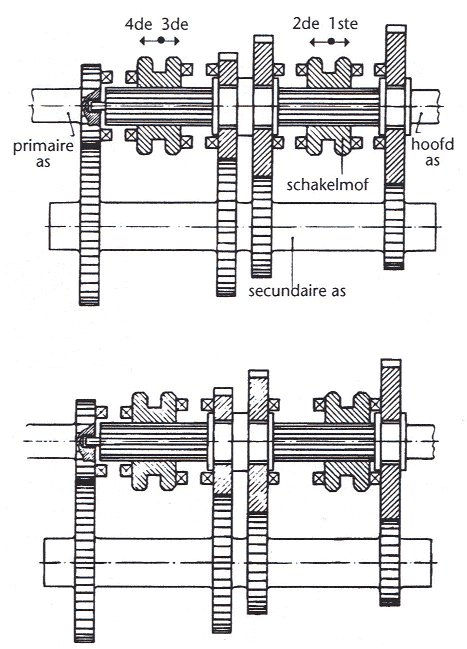
sliding mesh:
These are English words for 'slide' and 'interlock'. With this type of transmission, gears are shifted to engage a certain gear. This is still used today with reverse gears, but never really with modern gearboxes anymore, so we won't go into too much detail about it. The teeth are straight with a bevel at the ends. With this type of gearbox you will always hear a creaking when shifting because it is of course not synchronized.
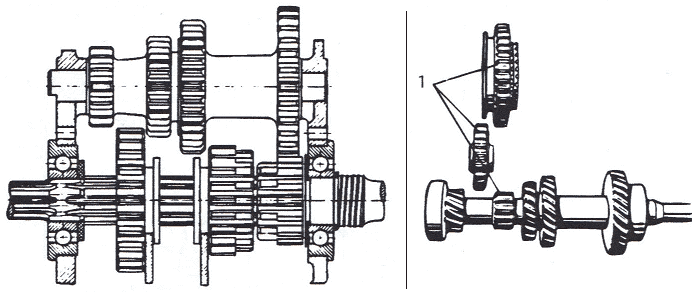
Gear ratios:
The gear ratios in the gearbox must be accurately calculated and constructed. The image below shows the vehicle speed on the X-axis and the force on the wheels on the Y-axis. It can be seen that 1st gear has a lot of power to the wheels, but stops at a low vehicle speed. Each gear after that has less power to the wheels and a higher speed range.
Click here to go to the Gear ratios page, where all gear ratios are calculated using the geometric series and the corrected geometric series (Jante's series) with the K factor.
The maximum vehicle speed can then also be calculated per transmission.
